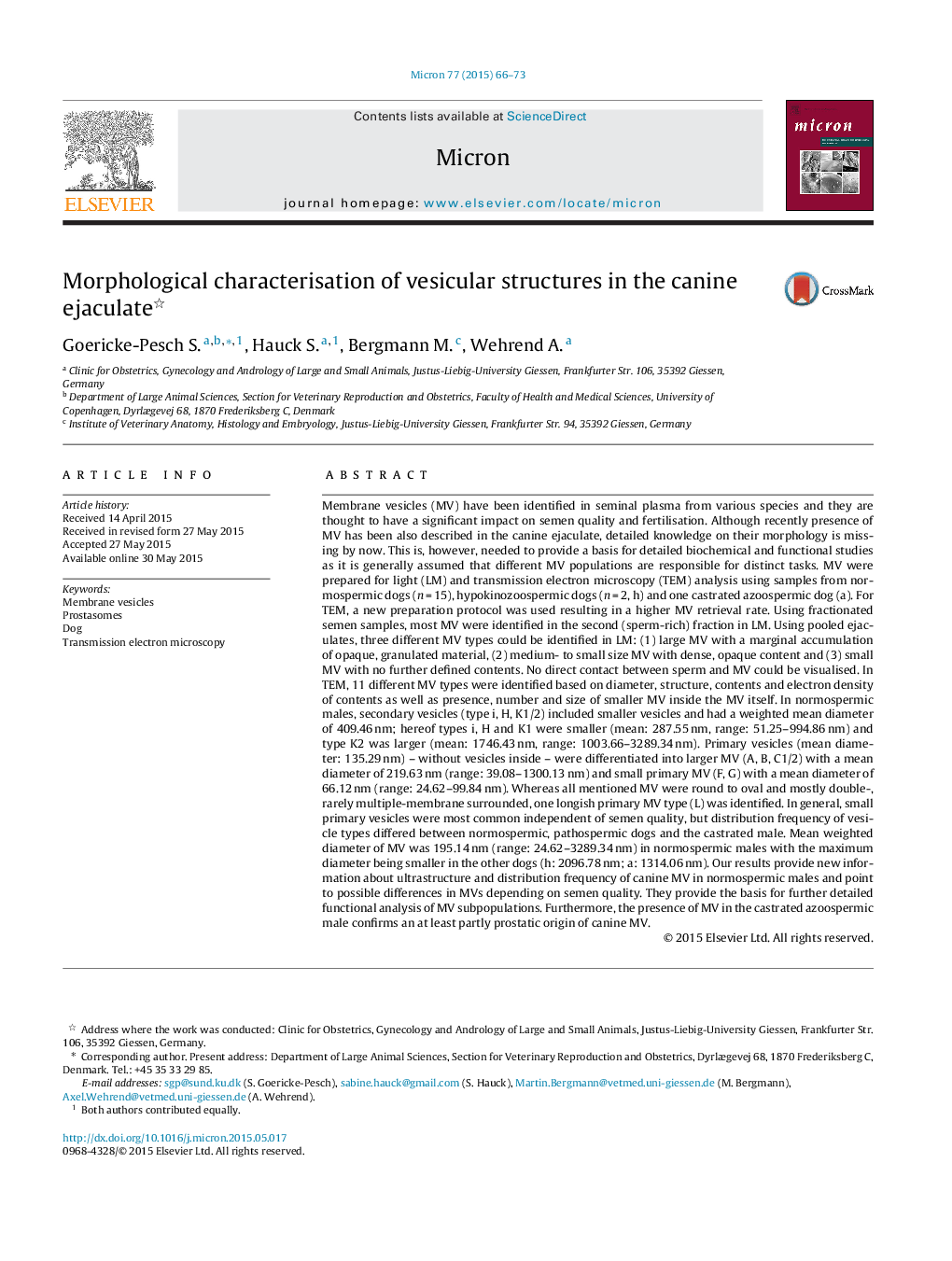| کد مقاله | کد نشریه | سال انتشار | مقاله انگلیسی | نسخه تمام متن |
|---|---|---|---|---|
| 1588797 | 1515139 | 2015 | 8 صفحه PDF | دانلود رایگان |
عنوان انگلیسی مقاله ISI
Morphological characterisation of vesicular structures in the canine ejaculate
ترجمه فارسی عنوان
مشخصات مورفولوژیکی ساختارهای حسی در انسداد کانکس
دانلود مقاله + سفارش ترجمه
دانلود مقاله ISI انگلیسی
رایگان برای ایرانیان
کلمات کلیدی
کیسه های غشایی، پروستاتوم، سگ، میکروسکوپ الکترونی انتقال،
موضوعات مرتبط
مهندسی و علوم پایه
مهندسی مواد
دانش مواد (عمومی)
چکیده انگلیسی
Membrane vesicles (MV) have been identified in seminal plasma from various species and they are thought to have a significant impact on semen quality and fertilisation. Although recently presence of MV has been also described in the canine ejaculate, detailed knowledge on their morphology is missing by now. This is, however, needed to provide a basis for detailed biochemical and functional studies as it is generally assumed that different MV populations are responsible for distinct tasks. MV were prepared for light (LM) and transmission electron microscopy (TEM) analysis using samples from normospermic dogs (n = 15), hypokinozoospermic dogs (n = 2, h) and one castrated azoospermic dog (a). For TEM, a new preparation protocol was used resulting in a higher MV retrieval rate. Using fractionated semen samples, most MV were identified in the second (sperm-rich) fraction in LM. Using pooled ejaculates, three different MV types could be identified in LM: (1) large MV with a marginal accumulation of opaque, granulated material, (2) medium- to small size MV with dense, opaque content and (3) small MV with no further defined contents. No direct contact between sperm and MV could be visualised. In TEM, 11 different MV types were identified based on diameter, structure, contents and electron density of contents as well as presence, number and size of smaller MV inside the MV itself. In normospermic males, secondary vesicles (type i, H, K1/2) included smaller vesicles and had a weighted mean diameter of 409.46 nm; hereof types i, H and K1 were smaller (mean: 287.55 nm, range: 51.25-994.86 nm) and type K2 was larger (mean: 1746.43 nm, range: 1003.66-3289.34 nm). Primary vesicles (mean diameter: 135.29 nm) - without vesicles inside - were differentiated into larger MV (A, B, C1/2) with a mean diameter of 219.63 nm (range: 39.08-1300.13 nm) and small primary MV (F, G) with a mean diameter of 66.12 nm (range: 24.62-99.84 nm). Whereas all mentioned MV were round to oval and mostly double-, rarely multiple-membrane surrounded, one longish primary MV type (L) was identified. In general, small primary vesicles were most common independent of semen quality, but distribution frequency of vesicle types differed between normospermic, pathospermic dogs and the castrated male. Mean weighted diameter of MV was 195.14 nm (range: 24.62-3289.34 nm) in normospermic males with the maximum diameter being smaller in the other dogs (h: 2096.78 nm; a: 1314.06 nm). Our results provide new information about ultrastructure and distribution frequency of canine MV in normospermic males and point to possible differences in MVs depending on semen quality. They provide the basis for further detailed functional analysis of MV subpopulations. Furthermore, the presence of MV in the castrated azoospermic male confirms an at least partly prostatic origin of canine MV.
ناشر
Database: Elsevier - ScienceDirect (ساینس دایرکت)
Journal: Micron - Volume 77, October 2015, Pages 66-73
Journal: Micron - Volume 77, October 2015, Pages 66-73
نویسندگان
Goericke-Pesch S., Hauck S., Bergmann M., Wehrend A.,
